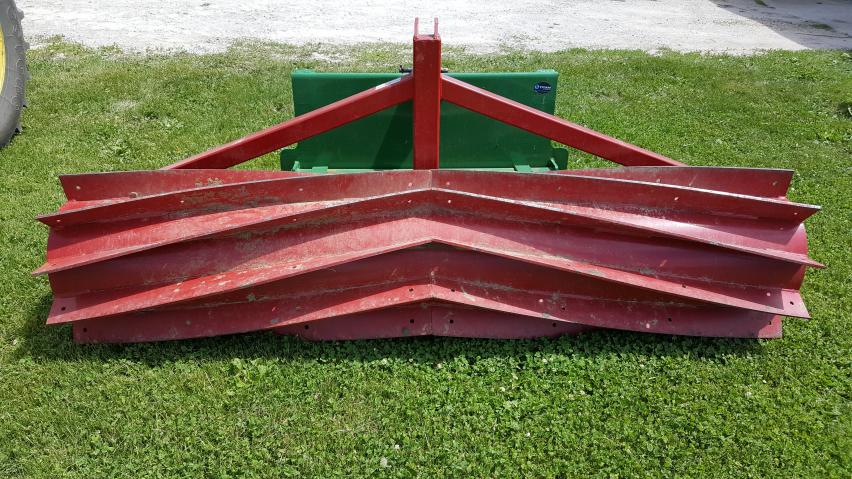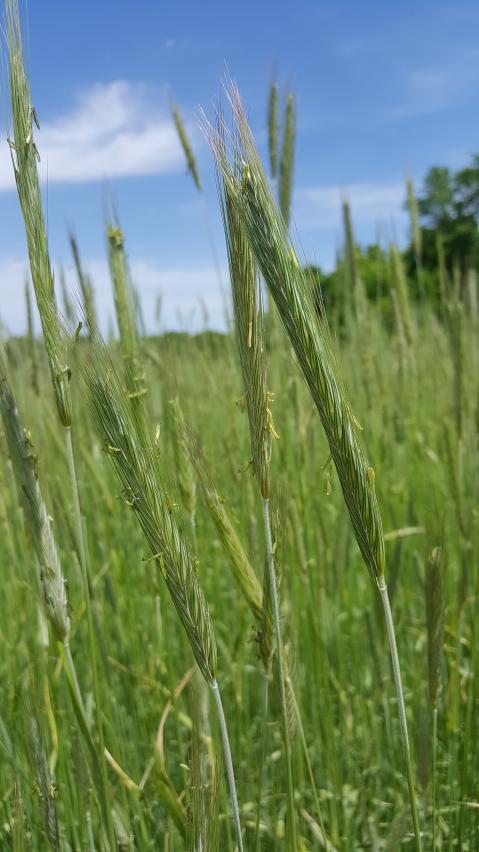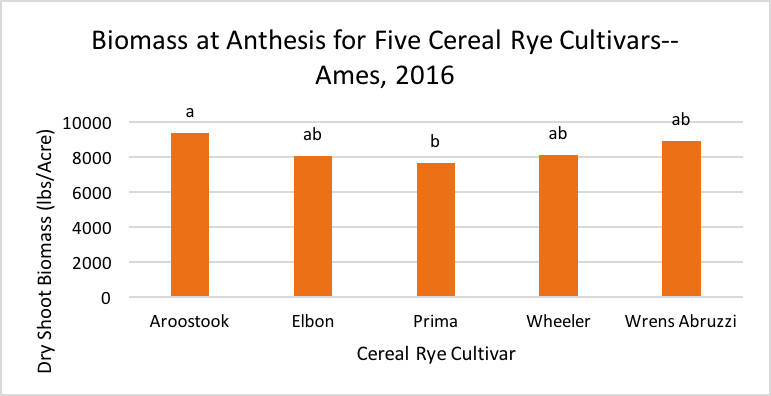By Kristine Neu, Department of Horticulture PhD Student; Ajay Nair, Department of Horticulture Assistant Professor
 Figure 1. The chevron pattern of the roller crimper serves to crimp cereal rye stems in several locations, effectively killing it while creating a mulch bed
Figure 1. The chevron pattern of the roller crimper serves to crimp cereal rye stems in several locations, effectively killing it while creating a mulch bed
This time of year brings harvest, preparations for winter and the planting of cover crops. Cereal rye is a popular and versatile cover crop that is planted in the fall and terminated in the spring. Traditional termination methods include chemicals, mowing, tilling and even crimping prior to planting of the row crop.
The roller crimper, originally designed by the Rodale Institute, is used to crimp the cereal rye stem in several places (Fig. 1). The flattened rye can create a mulch bed on top of the soil. Row crops or vegetables can be directly seeded through the mulch bed with a drill or a strip tiller. While knowledge about the management of cereal rye and roller crimping is becoming more commonplace, we are still uncertain which cultivar(s) performs best for Iowa and other Midwestern production systems.
In the fall of 2015, researchers at the Iowa State University Horticulture Research Station assessed five cereal rye cultivars (Table 1). Cereal rye was broadcasted at a rate of 110 pounds per acre using a Gandy drop spreader on two dates (Sept. 16 and Oct. 13). The seed was incorporated by tilling at a 2-inch depth. The planting date in October had to be irrigated to promote germination due to lack of rain. Plots from both planting dates were well established before winter.
Date of Anthesis and Roller Crimping
One of the most important objectives of this study is to determine the date of anthesis for each cereal rye cultivar (Fig. 2). Cereal rye cannot be successfully terminated with roller crimping until the rye has reached the reproductive stage. Planting date did not affect anthesis date in our study.
In 2016, Aroostook reached anthesis first (Table 1.). Rye in all plots was rolled and crimped on June 3. Four days after rolling and crimping, there were noticeable visual differences between the success of termination for each cultivar with Aroostook, Elbon and Wrens Abruzzi.
| Cultivar | Planting Date | Date of Anthesis |
| Aroostook | Sept. 16, 2015 | May 17, 2016 |
| Oct. 13, 2015 | May 17, 2016 | |
| Elbon | Sept. 16, 2015 | May 19, 2016 |
| Oct. 13, 2015 | May 19, 2016 | |
| Prima | Sept. 16, 2015 | May 21, 2016 |
| Oct. 13, 2015 | May 22, 2016 | |
| Wheeler | Sept. 16, 2015 | May 21, 2016 |
| Oct. 13, 2015 | May 22, 2016 | |
| Wrens Abruzzi | Sept. 16, 2015 | May 18, 2016 |
| Oct. 13, 2015 | May 19, 2016 |
Cereal Rye Biomass
 Figure 2.
Figure 2.
Prior to crimping rye in each of the plots, a 20-inch square of above-ground cereal rye biomass was collected. The biomass was dried and weighed to assess average dry weight biomass. Data was extrapolated to reflect dry weight biomass in pounds per acre. We were surprised that there was no difference between the September and October planting dates for biomass accumulation at termination. Had we not irrigated in October to ensure germination, differences in biomass accumulation by planting date may have been larger.
When examining the five cultivars, the only difference in biomass was between Aroostook and Prima. Aroostook had an average biomass of 9,387 pounds per acre and Prima had an average biomass of 7,647 pounds per acre. Cultivars Elbon, Wheeler and Wrens Abruzzi were intermediate in yield and did not differ from with Aroostook or Prima (Fig. 3). Increased biomass can contribute to increased water and nutrient retention, moderation of soil temperature and weed suppression, with the two latter elements also being evaluated in the study.
Carbon-to-Nitrogen Ratio
The carbon-to-nitrogen (C:N) ratio of plant material is a strong indicator of the ability of soil microbial organisms to break down organic matter into a useable source of N, making it an important variable to consider when using cover crops. Aroostook, Wrens Abruzzi and Elbon had significantly higher C:N ratios than Prima and Wheeler (Table 2). For soil microbial activity, a C:N ratio close to 25:1 is ideal. The lower C:N ratio of Prima and Wheeler would allow the mulch biomass to be more quickly broken down and converted to useable nitrogen. On the other hand, if a lasting mulch is desired for an entire growing season the cultivars with a higher C:N ratio may provide a mulch bed with more longevity.
 Figure 3. Shoot dry weight biomass collected at anthesis for five rye cultivars.
Figure 3. Shoot dry weight biomass collected at anthesis for five rye cultivars.
Conclusion
The study provided interesting information on how seeding dates influence various aspects of plant development and attributes (anthesis, biomass, and C:N ratio). Important points to highlight include:
- Seeding date (mid September vs mid October) did not significantly affect time to anthesis in cultivars tested.
- Between cultivars, Aroostook took less time to come to anthesis.
- Aroostook produced higher biomass when compared to Prima.
- High biomass production is critical in strip-tillage vegetable production, as growers rely on the thick mat of cereal rye to suppress weeds and reduce soil erosion.
- Plant C:N ratio was lower in Prima and Wheeler as compared to Aroostook, Wrens Abruzzi and Elbon, indicating a lower degree of N-immobilization.
| Cultivar | Average C:N Ratio |
| Aroostook | 58:1 a |
| Wrens Abruzzi | 58:1 a |
| Elbon | 57:1 a |
| Prima | 49:1 b |
| Wheeler | 47:1 b |
The full results of the 2015-16 cereal rye cultivar trial will be available in January 2017 in the Iowa State Research and Demonstration Farm Annual Report: http://farms.ag.iastate.edu/content/horticulture-research-station. For more information on projects being conducted by the ISU Sustainable Vegetable Production Lab, please visit http://www.extension.iastate.edu/vegetablelab/.




Post a comment
Report Abusive Comment